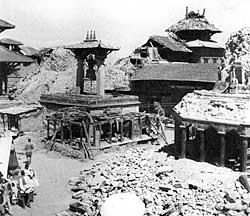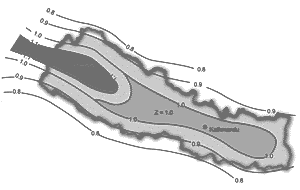 The earthquake on 17 July 2001 in Gorkha, which damaged 600 houses, brought home yet again that earthquakes are an unavoidable part of Nepal's future, just as they have been a part of its past. And as one more Earthquake Safety Day approaches, it looks as if we are still likely to be caught unprepared should a large trembler strike any time soon.
The earthquake on 17 July 2001 in Gorkha, which damaged 600 houses, brought home yet again that earthquakes are an unavoidable part of Nepal's future, just as they have been a part of its past. And as one more Earthquake Safety Day approaches, it looks as if we are still likely to be caught unprepared should a large trembler strike any time soon.
- Every year in Nepal there are more than 1,000 earthquakes ranging in magnitude from 2-5 on the Richter scale.
- Records going as far back as 1255 CE show that Nepal has experienced nine major earthquakes over the last 700 years.
- Recurring earthquakes in the 20th century claimed more than 23,000 lives.
- The Great Bihar earthquake of 1934-which could as well have been called The Great Kathmandu Earthquake-measured 8.3-8.4 on the Richter scale, claimed 8,500 lives and destroyed 20 percent of the Valley's buildings, including a large number of temples and monuments.
- In 1988, a magnitude 6.6 earthquake hit eastern Nepal, with the epicenter in Udayapur. More than 700 people were killed, 6,500 were injured and 22,000 houses collapsed.
"Kathmandu is the highest at-risk city in the world today," says Amod Dixit of National Society for Earthquake Technology-Nepal (NSET-Nepal). The Kathmandu Valley Earthquake Risk Management Project (KVERMP) estimates that an earthquake today similar in magnitude to the 1934 Mahabhukampa, centred in the densely populated Kathmandu Valley, would likely cause more deaths and casualties than last year's Gujarat earthquake in India. In hard numbers, they count something like approximately 40,000 dead and 95,000 injured. More than 60 percent of the existing buildings would be destroyed leaving 600,000 to 900,000 residents homeless.
It is a disaster waiting to happen-with a population of 1.5 million and growing, the Valley is seeing a spurt of uncontrolled development. Construction techniques have deteriorated in recent decades as the demand for cheap, fast buildings grows. Even scarier, the Valley's infrastructure barely holds up under day-to-day life, and is far from able to support rescue and response operations such as those carried out in Gujarat. One of the fundamentals drilled into the mind of every citizen of quake-prone countries is that earthquakes alone do not kill as many people as the collapse of poor infrastructure does. This means buildings, fire departments, medical facilities, and, if they exist, crisis management cells.
Nepal's seismic record seems to suggest that earthquakes of the 1934 magnitude occur approximately every 75 years. That, combined with recent seismic activity in the region, has led many experts to believe that a major earthquake is almost certain to hit in the near future. Nepal is in the seismically very active Himalayan mountain belt, with the Indian plate to the south moving burrowing against the Asian or Tibetan plate to our north. (See also "Waiting for the big one," #25.) A seismic risk map of Nepal produced by the United Nations Development Programme (UNDP) and United Nations Centre for Human Settlements (UNCHS) based on geological data, shows that the country's hills are more vulnerable to earthquakes than the mountains or the terai. And western and central Nepal-where a large percentage of the population and vulnerable infrastructure is concentrated-are more exposed than the far-east.
 The realisation that Nepal is as seismically active as Japan but much more vulnerable because of poor infrastructure planning came only after the 1988 earthquake. The ^Mahabhukampa, or nabbay saal ko bhuichalo, could have taught Nepal a lot, but public and institutional memory has proven to be short. An earthquake memorial, now known as Bhugol Park, was erected in 1934 to remind people of the damage the disaster caused. Nepal was the first Asian country to build such a monument, but it was not until 1988 that attention was refocused on actual earthquake preparedness. One of the products of this new concern was the creation of NSET-Nepal in 1994.
The realisation that Nepal is as seismically active as Japan but much more vulnerable because of poor infrastructure planning came only after the 1988 earthquake. The ^Mahabhukampa, or nabbay saal ko bhuichalo, could have taught Nepal a lot, but public and institutional memory has proven to be short. An earthquake memorial, now known as Bhugol Park, was erected in 1934 to remind people of the damage the disaster caused. Nepal was the first Asian country to build such a monument, but it was not until 1988 that attention was refocused on actual earthquake preparedness. One of the products of this new concern was the creation of NSET-Nepal in 1994.
NSET-Nepal believes that with concerted effort, Nepal can be quake resistant by 2020. The organisation helps people learn what "preparedness" means, in terms of how they build and organise their structures, and what their immediate response should be in the event of a quake. Still, Dixit worries. "Nepalis are very complacent and are not panicked easily," he says. "But to withhold the knowledge so as not to create panic is actually a crime." Dixit cannot emphasise enough that the only way to deal with such a disaster is to be always prepared, which means having long-term vision and patience.
One of the ways to do that is to see to it that quakes are never too far from the public mind. Which is why, though NSET-Nepal, with the support from the government declared Magh 2 (this year 15 January) every year as Earthquake Safety Day, they work around the year with institutions and communities to make the Valley a safer place, should there be a quake.
Probably their biggest success story has been the four-year-old School Earthquake Safety Project (SESP). Shocked to find that none of Kathmandu Valley's 643 public schools complied with even the nominal building code in place now, NSET-Nepal decided to strengthen the buildings by a process known as seismic retrofitting, by which even poorly-built structures can be stabilised to withstand quakes. Today, SESP is so popular that it is being replicated in India, Indonesia and other countries. Ram Hari Sharma, principal of Bal Bikas Madhyamik Vidhyalaya, one of the schools that has been retrofitted says, "I agreed when they selected my school, and now there are four or five houses in the area that have replicated what we did."
Starting 12 January, when Nepal's fourth annual Earthquake Safety Week begins, different organisations and experts will come together in public forums to raise awareness and discuss the problems raised by quakes. Lalitpur is the focus this year, and the week will kick off with the hand-over of the earthquake resistant Kaversthali School to the community. This will be followed by programmes such as a mass casualty drill at Machhendra bahal, a seminar on improving building standards, a symposium in disaster risk management, messages over radio and a discussion of the role of media in earthquake disaster management. Lalitpur's mayor Buddhi Raj Bajracharya says he plans to conduct awareness programmes in every ward of Lalitpur. "My aim is to bring down casualties when such a disaster occurs," he says. The municipality plans to make the approval of two design plans a requirement for any new construction, and already hands out a set of booklets on constructing for earthquake safety when it approves plans.
 The UN is also doing its bit. The UN Disaster Management Team (UNDMT), reactivated in 1999, has come up with the first UN Disaster Response Preparedness Plan in the world. Man Bahadur Thapa of the UN Disaster Management Programme, says the team has trained 47 government officials at the ministry level in disaster management and over 100 members of the larger community. The team also provides technical support to the three
The UN is also doing its bit. The UN Disaster Management Team (UNDMT), reactivated in 1999, has come up with the first UN Disaster Response Preparedness Plan in the world. Man Bahadur Thapa of the UN Disaster Management Programme, says the team has trained 47 government officials at the ministry level in disaster management and over 100 members of the larger community. The team also provides technical support to the three  groups that, should a quake hit, will work on food and agriculture, health, and logistics.
groups that, should a quake hit, will work on food and agriculture, health, and logistics.
Kathmandu grandparents, when asked about the


